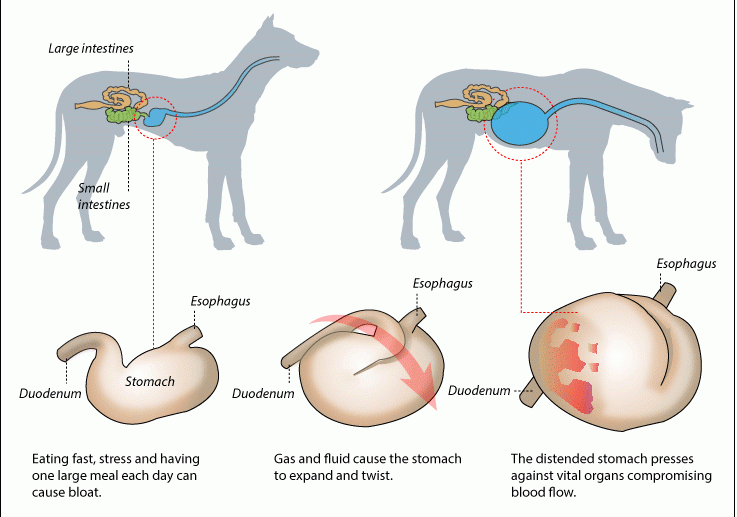Last Updated on July 14, 2024
It was a Friday night, and my goofy Great Dane, Gus, was his usual playful self. We’d just finished dinner – he scarfed down his kibble in record time, as always – and were getting ready for our evening walk. But something was different. Gus seemed restless, pacing around the living room, whining softly. His belly looked strangely swollen, and he kept trying to throw up, but nothing was coming out.
Panic surged through me. I’d heard horror stories about bloat, a terrifying condition that could strike large-breed dogs like Gus with lightning speed. My heart pounded as I rushed him to the emergency vet, praying we hadn’t waited too long.
That night was a blur of anxious waiting, frantic phone calls, and a whirlwind of medical jargon. Thankfully, Gus pulled through, but the experience left me shaken and determined to learn everything I could about bloat so I could protect him – and other dog owners – from this silent threat.
Table of Contents
ToggleBloat: Unmasking the Silent Killer
 Bloat, or Gastric Dilatation-Volvulus (GDV), is a true medical emergency. It happens when a dog’s stomach fills with gas, fluid, or food, causing it to swell like a balloon. In severe cases, the stomach can twist, cutting off blood supply to vital organs. Without immediate treatment, bloat can be fatal within hours.
Bloat, or Gastric Dilatation-Volvulus (GDV), is a true medical emergency. It happens when a dog’s stomach fills with gas, fluid, or food, causing it to swell like a balloon. In severe cases, the stomach can twist, cutting off blood supply to vital organs. Without immediate treatment, bloat can be fatal within hours.
Spotting the Signs: Every Second Counts
The key to surviving bloat is recognizing the symptoms early. Here’s what to watch for:
- Restlessness and Pacing: Your dog might seem agitated, unable to get comfortable, and pace constantly. This was one of the first signs I noticed with Gus.
- Unsuccessful Vomiting: They might try to throw up, but nothing comes out because the twisted stomach blocks the exit.
- Swollen Belly: You’ll likely notice a distended, firm abdomen, often described as a “pot-bellied” appearance.
- Excessive Drooling: Thick, stringy drool is common as the dog tries to cope with the discomfort.
- Pale Gums: If your dog’s gums are pale or bluish, it could signal poor circulation, a dangerous sign.
- Rapid Heartbeat: Their heart rate might increase as their body struggles to compensate.
- Weakness and Collapse: In severe cases, dogs can become weak, collapse, and go into shock.
If you see any of these signs, don’t hesitate. Rush your dog to the vet immediately!
Understanding the Risks: Why Some Dogs Are More Vulnerable
While any dog can develop bloat, certain factors increase the risk:
- Breed: Large, deep-chested breeds like Great Danes, German Shepherds, Standard Poodles, and, yes, my beloved Gus, are most susceptible. Their anatomy makes them more prone to stomach twisting.
- Feeding Habits: Feeding one large meal a day, especially before vigorous exercise, can contribute to bloat. I learned this the hard way with Gus.
- Genetics: Some breeds have a genetic predisposition to bloat. It’s worth researching your dog’s breed history to understand their risk.
- Stress: Stressful events, like thunderstorms or moving to a new home, can trigger bloat in susceptible dogs.
Prevention: Taking Charge of Your Dog’s Health
While there’s no foolproof way to prevent bloat, you can take steps to minimize the risk:
- Multiple Meals: Instead of one big meal, feed your dog two or three smaller meals throughout the day. I now feed Gus twice a day, and it’s made a world of difference.
- Slow Down Eating: Use slow-feeding bowls or puzzle feeders to prevent gulping and air swallowing. Gus used to inhale his food, but now he has to work for it, which is better for his digestion.
- Elevate Food Bowls: Raising food and water bowls can make eating more comfortable and reduce air intake.
- Manage Stress: Create a calm environment for your dog and minimize stressful situations. I’ve learned to recognize Gus’s anxiety triggers and take steps to keep him calm.
- Exercise Smart: Regular exercise is important, but avoid strenuous activity right after meals. A leisurely walk after dinner is perfect for Gus.
- Talk to Your Vet: Discuss your dog’s bloat risk with your veterinarian and follow their recommendations. They can provide personalized advice based on your dog’s breed, age, and lifestyle.
Treatment: A Race to Save Lives
If your dog shows signs of bloat, every second counts. Immediate veterinary care is essential. Treatment typically involves:
- Stabilization: The vet will provide oxygen, IV fluids, and pain relief to stabilize your dog’s condition.
- Decompression: A tube will be passed into the stomach to release the built-up gas and fluid, relieving pressure.
- Surgery: In most cases, surgery is required to untwist the stomach and perform a gastropexy, which permanently attaches the stomach to the body wall to prevent future twisting.
Recovery and Prognosis: Factors that Matter
The outcome for a dog with bloat depends on several factors:
- How quickly treatment is started: The sooner the better. Early intervention dramatically increases the chances of survival.
- Severity of tissue damage: If the stomach or spleen has been severely compromised, the prognosis may be more guarded.
- Overall health and age: Younger, healthier dogs tend to recover better.
- Post-operative care: Following your vet’s instructions for aftercare is crucial for a successful recovery.
Living with the Fear, Embracing the Hope
Bloat is a terrifying experience for any dog owner. It’s a constant worry for me, especially with a breed like Gus. But that night at the emergency vet taught me the power of knowledge and quick action.
 Dog N Treats All dogs deserve to be pampered
Dog N Treats All dogs deserve to be pampered


